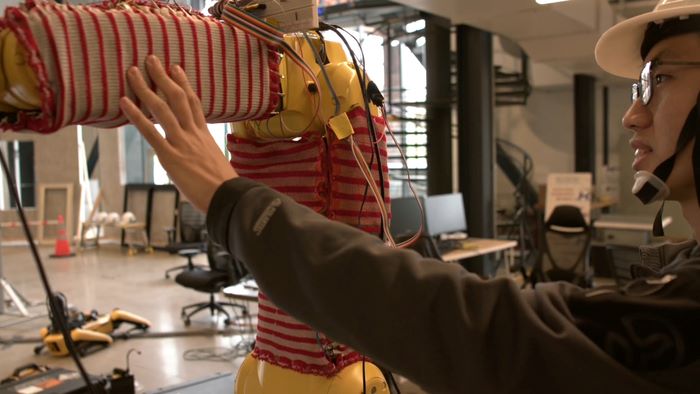The qualities that make a knitted sweater comfortable and easy to wear are the same things that might allow robots to better interact with humans.
RobotSweater, developed by a research team from Carnegie Mellon University’s Robotics Institute, is a machine-knitted textile “skin” that can sense contact and pressure.
“We can use that to make the robot smarter during its interaction with humans,” said Changliu Liu, an assistant professor of robotics in the School of Computer Science.
Just as knitters can take any kind of yarn and turn it into a sock, hat or sweater of any size or shape, the knitted RobotSweater fabric can be customized to fit uneven three-dimensional surfaces.
“Knitting machines can pattern yarn into shapes that are non-flat, that can be curved or lumpy,” said James McCann, an SCS assistant professor whose research has focused on textile fabrication in recent years. “That made us think maybe we could make sensors that fit over curved or lumpy robots.”
Once knitted, the fabric can be used to help the robot “feel” when a human touches it, particularly in an industrial setting where safety is paramount. Current solutions for detecting human-robot interaction in industry look like shields and use very rigid materials that Liu notes can’t cover the robot’s entire body because some parts need to deform.
“With RobotSweater, the robot’s whole body can be covered, so it can detect any possible collisions,” said Liu, whose research focuses on industrial applications of robotics.
RobotSweater’s knitted fabric consists of two layers of conductive yarn made with metallic fibers to conduct electricity. Sandwiched between the two is a net-like, lace-patterned layer. When pressure is applied to the fabric — say, from someone touching it — the conductive yarn closes a circuit and is read by the sensors.
“The force pushes together the rows and columns to close the connection,” said Wenzhen Yuan, an SCS assistant professor and director of the RoboTouch lab. “If there’s a force through the conductive stripes, the layers would contact each other through the holes.”
Apart from how to design the knitted layers, including dozens if not hundreds of samples and tests, the team faced another challenge in connecting the wiring and electronics components to the soft textile.
In future research, the team wants to explore how to program reactions from the swipe or pinching motions used on a touchscreen.
- EUREKALERT







